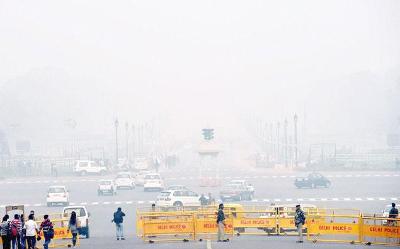Delhi today, your city tomorrow

Since 2011, at least 94 Indian cities have not met national air quality standards. Many of these cities have been on the list from the 1990s, say officials of the Central Pollution Control Board (CPCB).Neither the Centre nor the states have put in place a plan to ensure that cities get taken off this list.The World Health Organisation’s recent urban air quality database lists 10 Indian cities among the world’s 20 worst polluted. But that doesn’t seem to worry the CPCB or administrators either.
For the past couple of years when air pollution in Delhi, Kanpur, Lucknow and Varanasi touched dangerous levels, CPCB did nothing to ensure that its directions on meeting air quality standards were en forced. It also ignored its own studies, commissioned from Chittaranjan National Cancer Institute in 2003, on the impact of air pollution on children over 15 years, which found serious physical and psychological impacts.
The Centre has made only one major decision this year to tackle air pollution–notifying BSVI emission standards for vehicles manufactured after April 2020, which will bring down particulate emissions from vehicles by 60%-80%. The National Air Quality Standard notification, 2009, says safe standards for air should be met 98% of the year, a criterion none of the cities monitored by CPCB meet.Dipankar Saha, additional director, air laboratory at CPCB said: “This is not relevant anymore since we have started real-time monitoring of cities. We alert the nonattaining cities every three years.”
But CPCB only monitors 29 cities real time and has just one continuous air quality monitor at most locations.The rest are manual monitoring machines which are “highly inefficient” and at times “inaccurate”, say experts.
“Only when there is pressure from the people and the judiciary, cities start acting on pollution. There is no national policy. Even the government’s smart city project only makes a passing reference to air quality but doesn’t make it binding on cities to meet this criteria,” says Anumita Roy Chowdhury, head of Centre for Science and Environment’s clean air programme. CPCB’s air quality bulletins routinely show Faridabad, Agra, Kanpur and Lucknow in “severe” or “very poor” categories.
This month for the first time CPCB used its statutory powers to direct municipalities in NCR to take steps to curb air pollution. “The air act gives us statutory powers to issue closure orders or cut electricity or water supply to industries that do not meet norms but it doesn’t give us powers to penalize municipalities. So our directions are not binding on them,” said Saha. In this situation, he is not sure how air quality standards will be met in cities.




